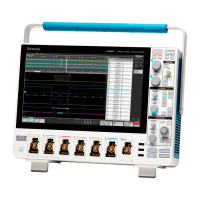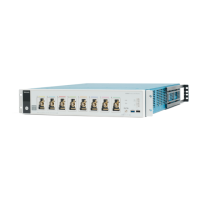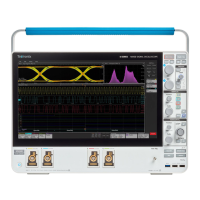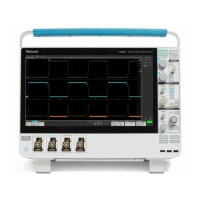Field or control Description
Vertical Scale Set the vertical scale by using the assigned multipurpose knob, a virtual keypad, or tap the up or down
arrows.
Label Adds a label to the waveform. Tap and enter text using a keyboard, or double-tap to open the virtual
keyboard. The label text is the same color as the waveform.
Once you have entered the label, close the menu and double-tap the label text to open the T
ext
Settings menu to change the font color, size, and other characteristics.
Units Set the units label that you want to display on the vertical scale.
Position Set the vertical position of the waveform using the assigned multipurpose knob or the virtual keypad.
Set to 0 Tap to set the vertical position to 0 (vertical center of the graticule).
Reference File Shows the path and file name of the current Reference waveform.
Double-tap the field to open the on-screen keyboard to enter or edit the path to open a different
waveform file.
Tap the down arrow icon to list the 20 most recently accessed reference waveform files.
Browse Opens the Browse Waveform File dialog. Use this dialog to navigate to and select a waveform file to
load. See Recall configuration menu (Ref waveform configuration menu) on page 210.
Sample Rate, Record Length Readout-only text that show the sample rate and record length values of the reference waveform.
Deskew Changes the horizontal position of the reference waveform. Use this function to align the reference
waveform to meet your measurement needs.
Set to 0 Sets the reference waveform deskew value to zero.
Recall configuration menu (Ref waveform configuration menu)
Use this menu to locate and load a reference waveform file.
Prerequisite: a Ref badge must be present on the Settings bar
. See Add a math, reference, or bus waveform on page 62.
To open the Recall configuration menu:
1. Double-tap a Ref badge on the Settings bar.
2. Tap Browse to open the Recall configuration menu.
Recall configuration menu (Ref configuration menu) fields and controls
Field or control Description
Look in Shows the current directory path and file name.
T
ap on the file path and use a keyboard to enter a new path. Or double-tap on the file name to open
the virtual keyboard and enter a path.
Tap the down arrow icon on the right end of the field to open a list of recently accessed files, up to a
maximum of 20.
Table continued…
Menus and dialog boxes
210
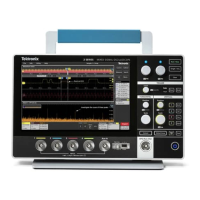
